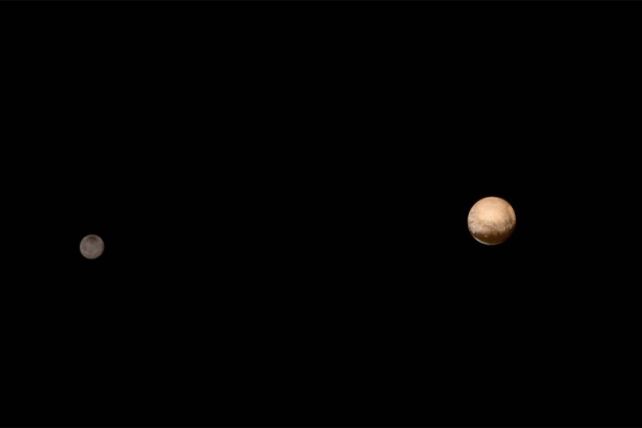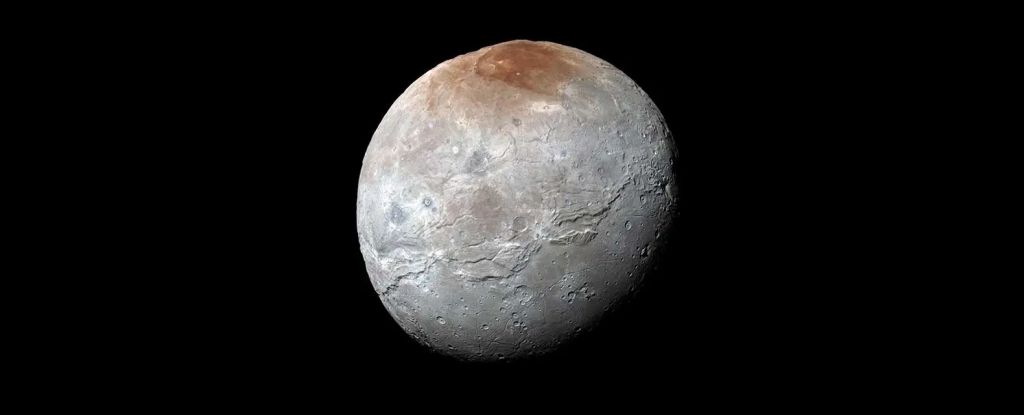Products You May Like
The love story between Pluto and Charon may have started with a kiss.
A new study suggests the dwarf planet and its scarcely smaller moon likely came together in a collision that saw them conjoined for a period of time, billions of years ago, before separating into a stable, long-term orbital dance.
This “kiss and capture” mechanism contradicts previous theories about the provenance of Charon that supposed it must have formed from a giant impact, like the one hypothesized to have formed Earth’s Moon.
“Most planetary collision scenarios are classified as ‘hit and run’ or ‘graze and merge’,” says planetary scientist Adeene Denton of the University of Arizona.
“What we’ve discovered is something entirely different – a ‘kiss and capture’ scenario where the bodies collide, stick together briefly and then separate while remaining gravitationally bound.”
The models used to understand the giant impact that formed Earth’s Moon work very well for bodies within the Solar System’s frost line – that is, the distance from the Sun at which gases such as water condense into frozen grains, at about five times the distance between the Sun and Earth.
frameborder=”0″ allow=”accelerometer; autoplay; clipboard-write; encrypted-media; gyroscope; picture-in-picture; web-share” referrerpolicy=”strict-origin-when-cross-origin” allowfullscreen>
Because Earth and the Moon are warmer and more gooey, especially during the early Solar System 4.5 billion years ago when they are thought to have split apart, they behave more like fluids during a giant impact.
The properties of Pluto and Charon, however, are a little tricky to resolve. Their diameters are 2,376 kilometers (1,476 miles) and 1,214 kilometers, respectively, and they are separated by a distance of around 19,500 kilometers, with a circular orbit around a mutual center of gravity.
The fact Pluto’s orbital axis is more or less perfectly aligned with Charon’s highly suggests they were both spun out of the same rotating mess following a collision, but the size and orbit of Charon are hard to resolve with this model.
But Pluto and Charon are different from Earth and the Moon, too – they are both smaller (the Moon is 3,475 kilometers across) and much, much colder, made up of rock and ice. When the researchers accounted for the strength of these materials compared to the large, warm, gooey Earth and Moon, they found that Pluto and Charon didn’t behave the same way.
frameborder=”0″ allow=”accelerometer; autoplay; clipboard-write; encrypted-media; gyroscope; picture-in-picture; web-share” referrerpolicy=”strict-origin-when-cross-origin” allowfullscreen>
Instead of a giant rock smashing into Pluto, merging, and spewing a huge amount of debris into space that over time coalesced into Charon over time, the two bodies would have come together and remained more or less unchanged, as their strength and density prevented them from wreaking further destruction on each other.
Instead, the team’s simulations show that Pluto and Charon would have stuck together for a time – much like the two lobes of distant Solar System object Arrokoth – as what is known as a contact binary. Both objects would have remained relatively intact, with their compositions unchanged, so that when they separated again, they kept their individuality.
Over time, the two bodies would separate to their current orbital distance, shape, and axis. The team’s simulations were able to replicate the observed orbital properties of the two bodies perfectly.

“The compelling thing about this study is that the model parameters that work to capture Charon, end up putting it in the right orbit. You get two things right for the price of one,” says planetary scientist Erik Asphaug of the University of Arizona.
The finding suggests that the formation of planetary bodies and their companions is more fascinating and diverse than we realized – and that skipping over physical properties can be deeply detrimental to a full understanding of how things work in the physical Universe.
It also gives astronomers a new tool for understanding the evolution of Pluto over time, a strange, rich world unlike any other in the Solar System.
“We’re particularly interested in understanding how this initial configuration affects Pluto’s geological evolution,” Denton says. “The heat from the impact and subsequent tidal forces could have played a crucial role in shaping the features we see on Pluto’s surface today.”
The research has been published in Nature Geoscience.
